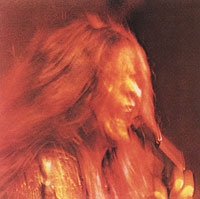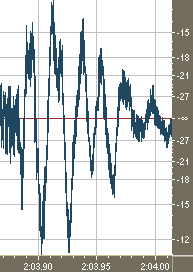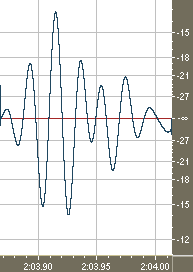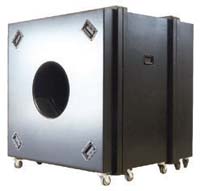Home Entertainment Blog Archive
Brought to you by your friendly, opinionated, Home Entertainment and Technology writer, Stephen DawsonHere I report, discuss, whinge or argue on matters related to high fidelity, home entertainment equipment and the discs and signals that feed them. Since this Blog is hand-coded (I like TextPad), there are no comments facilities. But feel free to email me at scdawson [at] hifi-writer.com. I will try to respond, either personally or by posting here emails I consider of interest. I shall assume that emails sent to me here can be freely posted by me unless you state otherwise.
This archive is for an uncertain period commencing Thursday, 31 July 2003

| 
|
But that clean frame is the last frame of a sequence of 13 clean frames. The lined one is the first of a sequence of 12 interlaced frames. This sequence seems to continue throughout the movie: 12 dirty, 13 clean, 12 dirty. Of course it has not escaped my notice that 13+12=25, which is the number of PAL frames per second. Perhaps there was some kind of weird conversion process from NTSC source.
And, indeed, there is evidence for this. The Title holding the movie on the DVD is a little over 124 minutes in duration. IMDB reports the movie length as 123 minutes. Normally when transferred to PAL, the switch from 24 frames per second (film frame rate) to 25 fps (PAL frame rate) reduces the movie running time by four per cent. So this movie would run 118 minutes in PAL, not 124 minutes (the additional minute or so of running time on the DVD is in part accounted for a 10 second MGM lion at the start, plus another 17 seconds of MGM and StreamAV logos on the tail).
So it seems that the encoding method preserved the running time (and, incidentally, the absolute frequency spectrum of the sound) at the cost of heavy interlacing for half of each second of video. I suspect that all this has something to do with the source material with which StreamAV was provided. The giveaway: the English subtitles are hard-coded onto the movie (which must be intensely irritating for Mandarin speakers). Given its high quality work on other titles, I can't imagine StreamAV doing this.
UPDATE (Tuesday, 5 August 2003, 3:24 pm): StreamAV replies:
The artefact is from the NTSC to PAL transfer, and existed on the master we were delivered. There are a few other NTSC to PAL problems in there as well. It basically came down to the distributor having to make a decision about whether to release the product locally or not. They did the best they could with a title that's not going to sell a lot of copies.
 Janice Joplin's Bass noise -
Sunday, 3 August 2003, 10:18 am
Janice Joplin's Bass noise -
Sunday, 3 August 2003, 10:18 am
The audio producers of CDs and other music really do need the best possible monitoring equipment. Unfortunately, far too many (particulary those preparing stereo material) seem to rely on relatively small direct field monitors that, unfortunately, are somewhat bass deficient. This didn't matter in the old days when LPs ruled, because the cutting engineer would make sure that there was no deep bass anyway. On an LP, despite the RIAA equalisation curve, deep bass would create wide groove excursions and use up the limited real estate on the surface of the record.
Now consider Janis Joplin's recording I Got Dem Ol' Kozmic Blues Again Mama!, with a truly wonderful set of music. My CD is on the Columbia/Legacy label (CK 65785) which was remastered and had some bonus tracks tacked on the end. Track 2, 'Maybe', has some disturbing bass junk on it.
Let's have a close look at a section of this track, start at 2:03.867 into it and lasting for just 0.145 seconds. Here are three looks at the right channel of this brief section of music:

| 
| 
|
| Unfiltered | Low pass filtered
at 60 hertz Frequency=50 hertz | Low pass filtered
at 30 hertz Frequency=27.6 hertz |
Just pondering my last post ('Rumbling a Subwoofer with a Cartoon') and thinking about those high levels of infrasonic sound. If we posit that there were such a thing as a subwoofer that would deliver down to ten hertz or lower without attenuation, would it be enjoyable? On Titan A.E., I suspect not. Such high levels at such low frequencies would primarily rattle stuff in the listening room and, possibly, make one feel physically ill.
The chances are that the people creating the audio were using a subwoofer no more competent than my own. Consequently, they would most likely not have heard (or, rather, felt) all the very deep bass they were creating. If high fidelity is your listening aim then, somewhat perversely, the best system to listen to any material is not necessarily the best system, but a system with similar characteristics to the monitoring system used by the producers of the audio.
 Do you like showing off your subwoofer? There are a number of DVDs that do the job fairly well, but my favourite is the otherwise forgettable
Titan A.E. Fox animated movie. In particular, the first six minutes or so before the main title comes up.
Do you like showing off your subwoofer? There are a number of DVDs that do the job fairly well, but my favourite is the otherwise forgettable
Titan A.E. Fox animated movie. In particular, the first six minutes or so before the main title comes up.
But will your subwoofer deliver all the bass on this DVD as spaceships are taking off, the Earth explodes, and the Moon is impacted by a huge chunk of it? I'd say that the chances are 99:1 that it won't.
The audio spectrum shows one representative three second snippet. Note the peak output is at 34
hertz, but even at 10 hertz the level is only around 9dB down from that peak, and well above just  about everything above 100 hertz. This will test out a subwoofer. (Note, this is from the PAL DVD. For the US version these frequencies will be four per cent lower -- ie. a 32.6 hertz peak.)
about everything above 100 hertz. This will test out a subwoofer. (Note, this is from the PAL DVD. For the US version these frequencies will be four per cent lower -- ie. a 32.6 hertz peak.)
But most subwoofers, despite the name, will not produce much significant output below 30 hertz. The so-called subwoofers with a lot of inexpensive surround systems will rarely go much below 40 hertz. Strong output at 20 hertz? Expect to spend well over $AUS2,000. Fifteen hertz? Double that amount of money!

I use a Paradigm Servo 15 (~$AUS4,000) (see this review and this one and this one). This is very strong down to around 16 hertz, and it produces not just audible rumbling, but on this section of the movie seems to make the air of the room pulsate with energy. Quite an experience!
But what I'd really like to do is to is repeat the experience with a Whise Profunder 319A sub. Or even better, a Whise Profunder 616 passive sub, with suitable amplification. Fortunately the concrete is around 600mm thick under that corner of the room (the 616, sans-amplification, weighs 230kg)!
The same paper, the same day, makes two further errors in regard to recordable DVDs.
In a discussion of DVD-RAM, it says that it 'is a standard for recording information through a RAM drive in a personal computer rather than a video recorder.' This is not correct. Of the three major DVD Recorder manufacturers, Panasonic's lineup are all DVD-RAM compatible (and not DVD-RW). Indeed, the one real advantage DVD-RAM has over all the other formats is implemented in Panasonic recorders: it can be recorded and read simultaneously, so Panasonic has implemented a 'Time Shift' feature. The disadvantage is that only Panasonic DVD players appear to support DVD-RAM playback.
Then it dismisses DVD+RW and DVD+R as 'more limited in their compatibility with DVD players and DVD-ROM drives' than DVD-R and DVD-RW. In fact, things aren't as simple as this. A September 2002 Intellikey Labs survey produced compatibility figures of 90% for DVD+R, 77% for DVD-R, 72% for DVD+RW and 66% for DVD-RW. Yet it seems that in July 2002, Intellikey Labs did another survey which gave results of 78% for both DVD+R and DVD-R, 63% for DVD+RW and 58% for DVD-RW. More on the methodologies generating these different results is here. Yet a third study, this time conducted by CDRInfo.com gave it to DVD-R over DVD+R, 97% to 87%.
Not satisfied? HP reports (170kB PDF file) that Intellikey has done more studies, in January and March 2003, with cumulative results of DVD+R 96%, DVD-R 85%, DVD+RW 79% and DVD-RW 76%.
Clearly the whole compatibility issue is unclear. Both types of discs seem to work better in more recent players, and this is likely to get better as further new player models are introduced.
Ah, an Australian newspaper (which shall remain nameless) reports:
The new [DVD Audio] standard, based on the MPEG-2 format used in DVD video, uses the extra storage to produce a high quality audio recording that more closely replicates the sound musicians hear in the recording studio.Sorry, but that's quite wrong. There actually is an MPEG Level 2 audio format used on some DVDs (eg. Evita and 20,000 Watt R.S.L.: The Midnight Oil Collection), but that has been around since the inception of DVD. All video DVDs are required under DVD Forum rules to contain at least one of the following audio formats: Dolby Digital, PCM (ie. like a CD) or, for countries outside the United States, MPEG2. (That's why DTS DVDs always also have a Dolby Digital sound track). In the early days of DVD some Australian and European DVD producers thought that MPEG2 might end up being the format of choice, so they included this on some titles. Nobody uses MPEG2 for audio any more.
DVD Audio uses an entirely different technology. First, it's PCM based, but instead of using the CD's 16 bits of resolution and a 44,100 hertz sampling rate, it can use either 16 or 24 bits and anything from 48,000 to 192,000 hertz. Most tend to deliver 24 bits and 88,200 or 96,000 hertz in six channels.
Second, it does not use any form of 'lossy' compression such MPEG, Dolby Digital or DTS. These 'lossy' schemes work like MP3 (which, technically, is MPEG Level 1, Layer 3) and Sony's ATRAC (used in the MiniDisc), using psycho-acoustic algorithms to eliminate bits of the signal that their designers believe people cannot hear. Of course audiophiles dispute this, with some justice.
The audiophile selling point of DVD Audio is that the audio format, in addition to using higher resolution bit depths and sampling rates, does not involve any 'lossy' compression. There is a compression system used, called Meridian Lossless Packing (MLP -- sometimes called Packed PCM or PPCM), developed by UK audiophile equipment firm Meridian. This essentially manages to get the amount of PCM data down to somewhat less than half the size it would otherwise occupy (compared to 10:1 or more reductions for some of the lossy systems), but without using any pscho-acoustic trickery. The system is designed to allow a perfect reconstruction of the original signal. Rather than being MPEG, Meridian licensed MLP to Dolby Laboratories which took up the cudgels to have it specified as the standard DVD Audio format.